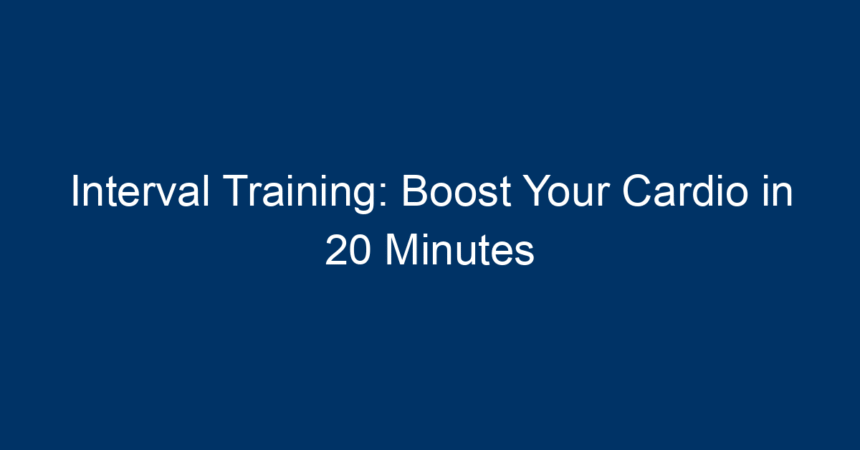In the fast-paced world we live in, finding time to exercise can be a daunting task. The good news? You can transform your cardio workout and achieve remarkable results in as little as 20 minutes through interval training. This high-intensity training method is designed to maximize efficiency and effectiveness, allowing you to burn calories, improve cardiovascular fitness, and enhance endurance in a fraction of the time. In this article, we’ll delve deep into the benefits of interval training, how to get started, and some practical workouts to integrate into your routine.
What is Interval Training?
Interval training involves alternating between periods of high-intensity exercise and low-intensity recovery or rest. This technique is not only effective but also keeps your workouts dynamic and engaging. By incorporating short bursts of intense effort followed by recovery, interval training takes your heart rate up and down, leading to improved aerobic and anaerobic fitness.
The Science Behind Interval Training
Research shows that interval training can lead to greater cardiovascular improvements compared to steady-state exercise. Notably, high-intensity intervals can stimulate adaptations in the muscles and cardiovascular system that enhance both endurance and strength.
Benefits of Interval Training:
- Increased Calorie Burn: Given its intensity, you burn more calories in a shorter amount of time.
- Improved Cardiovascular Health: Engaging in high-intensity intervals boosts circulation and heart health.
- Enhanced Metabolic Rate: Studies indicate that workouts involving intervals can elevate your metabolism for hours post-exercise, a phenomenon known as excess post-exercise oxygen consumption (EPOC).
- Time Efficiency: Perfect for busy schedules—20 minutes is all you need to make a significant impact on your fitness.
- Variety: It keeps workouts fresh and enjoyable, preventing boredom from monotonous workouts.
Getting Started with Interval Training
Assess Your Fitness Level
Before diving into interval training, it’s vital to assess your current fitness level. If you’re new to exercising, consider starting with moderate-intensity activities. Once you feel comfortable, gradually incorporate intervals into your routine.
Choose Your Exercise Type
Interval training can be applied to various types of cardiovascular workouts, including running, cycling, swimming, or even bodyweight exercises. Choose an activity that you enjoy, as this will increase your adherence to the program.
Warm-Up is Essential
A proper warm-up is crucial to preventing injuries. Spend 5-10 minutes warming up with dynamic stretches or low-intensity movements to prepare your body for the hard work ahead.
Sample 20-Minute Interval Workouts
Here are some effective interval training workouts you can try, each designed to elevate your heart rate and boost your cardio fitness within just 20 minutes.
1. Interval Running Workout
Workout Format:
- Warm-Up: 5 minutes of brisk walking or light jogging.
- Workout:
- 30 seconds sprint at maximum effort.
- 90 seconds walking or slow jogging for recovery.
- Repeat: 8 rounds.
- Cooldown: 5 minutes of walking.
This workout not only improves speed and endurance but also enhances cardiovascular capacity.
2. Cycling Intervals
Workout Format:
- Warm-Up: 5 minutes at an easy pace.
- Workout:
- 20 seconds of intense cycling (maximum effort).
- 40 seconds of slow cycling for recovery.
- Repeat: 10 rounds.
- Cooldown: 5 minutes of easy cycling.
Cycling intervals are fantastic for improving leg strength and cardiovascular endurance while being low-impact.
3. Bodyweight Circuit
Workout Format:
- Warm-Up: 5 minutes of dynamic stretches.
- Workout:
- 30 seconds of high knees.
- 30 seconds of rest.
- 30 seconds of jumping jacks.
- 30 seconds of rest.
- 30 seconds of burpees.
- 30 seconds of rest.
- 30 seconds of mountain climbers.
- 30 seconds of rest.
- Repeat: 2-3 times.
- Cooldown: Stretching for 5 minutes.
This bodyweight circuit is perfect for those who prefer home workouts or don’t have access to equipment.
Tips for Successful Interval Training
To maximize the effectiveness of your interval training sessions, consider these tips:
1. Start Slow
If you’re new to intense workouts, start with fewer intervals, or longer recovery times, and gradually build intensity and duration.
2. Focus on Form
Maintain proper form throughout each exercise to prevent injuries. Quality supersedes quantity, especially in high-intensity workouts.
3. Stay Hydrated
Hydration is key when performing any physical activity. Ensure you drink plenty of water before, during, and after your workout.
4. Use Music or a Workout Buddy
Music can provide motivation and keep your energy high during workouts. Alternatively, working out with a friend can make the process more enjoyable.
5. Listen to Your Body
Pay attention to how your body feels during and after workouts. If you experience pain or excessive fatigue, consider adjusting your routine.
When to Schedule Your Workouts
Interval training can be a great addition to your overall fitness routine. Aim to include it 2-3 times a week, allowing your body ample recovery time between sessions. On other days, you can engage in moderate-intensity exercises like walking, swimming, or yoga for balanced fitness.
Conclusion: Transform Your Fitness in 20 Minutes
Incorporating interval training into your cardio routine can revolutionize your workouts and significantly improve your fitness levels in just 20 minutes. By alternating between high-intensity exercise and recovery, you not only save time but also enhance your cardiovascular health, boost metabolism, and keep your workout sessions engaging.
Remember, the key to successful interval training lies in consistency, progression, and listening to your body. So why wait? Grab your sneakers, choose your workout, and get ready to elevate your fitness. Each 20-minute session can be your stepping stone to a healthier, fitter lifestyle. Happy training!




